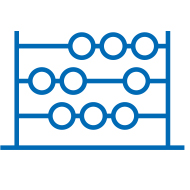Summary of composition and learning time
We have designed each course to be about three months (once a week :12 weeks) in duration. The study time for each session is about 10 to 15 minutes. We also offer 20 to 30 minutes content courses for advanced students. However, the study time for the cognitive ability class varies depending on individual performances. Approximate duration is to be used as a reference. If you do not finish your course in time, you can continue to study at the next class. [Note] The volume and learning time of the aptitude development class is different from the summary described above. Please refer to the description of the examples and content of the course.







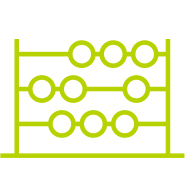
Quantitative ability calculation
During early childhood, enhancing mathematical literacy is more important than simply learning how to calculate. Mathematical literacy is the ability to imagine numbers in terms of quantity and is commonly known as "quantitative ability". Using this ability to quantify numbers, children can more easily understand numerical comparison, decomposition and synthesis, which is a mathematical literacy ability (comparable to an understanding of complementary numbers). The purpose of this lecture is to cultivate the student's mathematical literacy in future application by elevating their quantitative ability level when making calculation. [Note] Learning to calculate is only a by-product of the process, and the ability to calculate is only a small part of one's mathematical ability. It is important to enhance the student's mathematical literacy (sense for quantity) and elevate their overall arithmetic ability. In addition, for students whose understanding is significantly lower than other students, we recommend that they use the "calculation block" in the selective textbook.
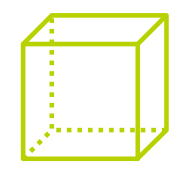
Mathematical puzzles
This is a mathematical puzzle lecture to nurture student's thinking ability. In order to develop students' thinking, it is necessary first to "make their mind flexible." To this end, the following two types of training must be carried out: ① thinking about different things at the same time; ② trial and error. In order to achieve this training, the most appropriate teaching materials are mathematical puzzles that require almost no knowledge at all. And the more difficult the problem, the more significant the effect. GSL has prepared an excellent range of puzzles in this area, so that even if an student encounters difficulties, they would eagerly confront the problem; in other words, even if they are unable to solve difficult puzzles quickly, they will persevere and strive to overcome the challenge.
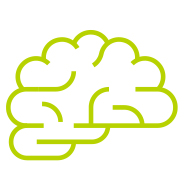
Shapes and space
The objective of this lecture series is to cultivate spatial awareness. In the past, it was commonly thought that in order to nurture one's spatial awareness, the only way was to nurture one's three-dimensional perception. In 2001, however, it was found that enhancement training in one's cognitive ability──especially an awareness of the three "parallel, symmetrical, rotating" planes──is a shortcut for accelerating the development of spatial cognitive skills. GSL courses have also adopted this learning method. In the shapes unit, the most important aspect is not knowledge but perception (spatial literacy), among which the most representative is spatial cognitive ability. The reason that some students study hard yet still have a hard time coping with shapes is because their spatial cognitive ability is deficient. A high level of spatial cognitive ability also indicates a strong imaginative capacity, which leads to an enhanced ability to understand units beyond an understanding of shapes. From the above perspective, cultivating a student's spatial cognitive ability in the early childhood to primary school stage is extremely important.

Quantitative perception mathematics
This is a comprehensive series of mathematical lectures for primary school students. Although judging from the unit, its content resembles other primary school study courses, it contains many units offering different ways to guide the students' interests. The ability to imagine numbers in terms of quantity is called quantitative ability, and the ability to compare, decompose and synthesize numbers is called mathematical literacy. Going beyond numbers, almost every unit with the exception of shapes has a numerical comparison content, so a quantitative ability in different areas is very important. However, as the general mathematics level becomes more difficult, it is necessary to use not only quantitative thinking but also simple applications of formulas or laws to solve problems. Although high school students and above should have no difficulty solving problems using this method, primary students should be studying mathematics with the purpose of cultivating their thinking ability through quantitative comparison and learning methods unique to mathematical thinking. Even so, overlooking the result-driven ideology of processes alters the nature of primary school mathematics which should be about cultivating thinking and mathematical literacy. This is a comprehensive mathematics lecture where students will learn the necessary knowledge. But, as mentioned earlier, this course teaches not only simple numbers but also cultivates a quantitative thinking through a variety of units (a quantitative sense of mathematics). In addition, even though the shapes awareness taught here is guided by knowledge, it is recommended that students listen to "Shapes and space" at the same time to enhance their spatial cognitive ability and literacy about shapes.
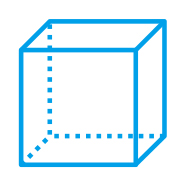
Shapes and space
The objective of the lecture series is to cultivate spatial awareness. In the past, it was commonly thought that in order to nurture one's spatial awareness, the only way was to nurture one's three-dimensional perception. In 2001, however, it was found that enhancement training in one's cognitive ability──especially an awareness of the three "parallel, symmetrical, rotating" planes──is a shortcut for accelerating the development of spatial cognitive skills. GSL courses have also adopted this learning method. In the shapes unit, the most important aspect is not knowledge but perception (spatial literacy), among which the most representative is spatial cognitive ability. The reason that some students study hard yet still have a hard time coping with shapes is because their spatial cognitive ability is deficient. A high level of spatial cognitive ability also indicates a strong imaginative capacity, which leads to an enhanced ability to understand units beyond an understanding of shapes. From the above perspective, cultivating a student's spatial cognitive ability in the early childhood to primary school stage is extremely important. In addition, please refer to "Quantitative mathematics" lectures 1 to 5 for further study of the knowledge of shapes outside of spatial ability.
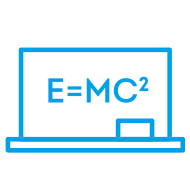
Mathematical puzzles (reasoning)
This is a lecture series to develop thinking ability with mathematical puzzles. These puzzles not only can cultivate hypothetical thinking ability, but also cultivate rational thinking ability.

Mathematical puzzles (Sudoku)
This is the world's most popular mathematical puzzle and is very effective for cultivating thinking ability. In addition, because this puzzle has a wide range of difficulty, it is suitable for a variety of ability and can be sustained for a long time.

Mathematical puzzles (integrated)
This is a lecture series to develop students' thinking skills using a variety of arithmetic puzzles. In addition, this is not an online lecture but involves actual teaching materials. Please take time to create a rubber eraser hill. While engaging in trial and error, students should reflect on their own combat strategy and continue to train and practise.





